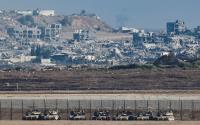Common Dreams / Published on Friday, March 2, 2007 by the Los Angeles Times Ralph Vartabedian
The Energy Department will announce today a contract to develop the nation's first new hydrogen bomb in two decades, involving a collaboration between three national weapons laboratories, The Times has learned.
 The mushroom cloud of the first test of a hydrogen bomb is seen in a 1952 file photo. The Bush administration is planning to develop a new hydrogen bomb - undermining efforts to stop nuclear proliferation. (Handout/Reuters) The mushroom cloud of the first test of a hydrogen bomb is seen in a 1952 file photo. The Bush administration is planning to develop a new hydrogen bomb - undermining efforts to stop nuclear proliferation. (Handout/Reuters) |
Teams of scientists in California and New Mexico have been working since last year to develop the new bomb, using the world's most powerful supercomputers.
The weapon is known as the reliable replacement warhead and is intended to replace aging warheads now deployed on missiles aboard Trident submarines.
The contract decision was made by the Nuclear Weapons Council, which consists of officials from the Defense Department and the National Nuclear Security Administration, part of the Energy Department. Plans were underway Thursday to announce the award this afternoon.
The nuclear administration will issue the contract and run the program.
The cost of the development is secret, though outside experts said it would cost billions of dollars — perhaps tens of billions — to develop the bomb, build factories to restart high-volume weapons production and then assemble the weapons.
If Livermore does become the lead laboratory, confidence in the facility is likely to be bolstered, and political suggestions that its role in weapons development is unnecessary could be quelled.
A lead role by Los Alamos would help extract that facility from deep political problems growing out of security breaches.
The program is not expected to create a surge in employment at any of the labs
The program marks the first time the military has fielded a nuclear weapon design without an underground test. The last time scientists set off a hydrogen bomb was in 1991 under the Nevada desert.
President Clinton ordered a testing moratorium, and it has been continued by President Bush.
Since the reason for building the new bomb is to maintain confidence in the nation's nuclear deterrent, experts say, the Nuclear Weapons Council will want the most conservative design, which gives Livermore the upper hand.
The design details are secret, but Livermore's version utilizes major components that had been tested — though not produced — for a Navy bomb about two decades ago.
By contrast, Los Alamos selected a design that involved an atomic trigger and a thermonuclear component that had been tested individually.
However, the two elements were never tested together, said Philip Coyle, who serves on scientific advisory committees and formerly was deputy director at Livermore.
The Los Alamos design is said to contain highly attractive features, including innovative mechanisms that would prevent terrorists from detonating the bomb should they gain access to it, experts said. Those use controls were cited by military officials as a key factor in developing the weapon.
Proponents of the effort say that the nation's existing nuclear stockpile is getting old and that doubts will eventually grow about weapons reliability. They say the new bomb will not have a greater nuclear yield and could not perform any new military missions beyond those of existing weapons.
So far, those arguments have attracted bipartisan support, including from Democrats who have long played a leading role in nuclear arms issues.
Critics say the existing stockpile is perfectly reliable and can be maintained for decades. The new bomb will undermine U.S. efforts to stop nuclear proliferation, they say. In addition, a recent study showed that plutonium components in existing weapons were aging much more slowly than expected.






